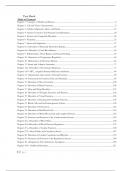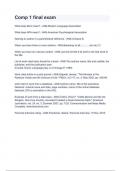Test Bank
Table of Contents
Chapter 1- Concepts of Health and Disease ........................................................................................................................... 2
Chapter 2- Cell and Tissue Characteristics .............................................................................................................................. 9
Chapter 3- Cellular Adaptation, Injury, and Death............................................................................................................... 15
Chapter 4- Genetic Control of Cell Function and Inheritance........................................................................................... 20
Chapter 5- Genetic and Congenital Disorders ...................................................................................................................... 26
Chapter 6- Neoplasia ................................................................................................................................................................. 32
Chapter 7- Stress and Adaptation ............................................................................................................................................ 37
Chapter 8-a- Disorders of Fluid and Electrolyte Balance.................................................................................................... 43
Chapter 8-b- Disorders of Acid-Base Balance ...................................................................................................................... 49
Chapter 9- Inflammation, Tissue Repair, and Wound Healing .......................................................................................... 55
Chapter 10- Alterations in Temperature Regulation ............................................................................................................ 60
Chapter 10- Mechanisms of Infectious Disease .................................................................................................................... 66
Chapter 11- Innate and Adaptive Immunity.......................................................................................................................... 71
Chapter 12-a- Disorders of the Immune Response ............................................................................................................. 77
Chapter 12-b- HIV_ Acquired Immunodeficiency Syndrome ........................................................................................... 84
Chapter 13- Organization and Control of Neural Function ............................................................................................... 90
Chapter 14- Somatosensory Function, Pain, and Headache ............................................................................................... 96
Chapter 15- Disorders of Motor Function ..........................................................................................................................102
Chapter 16- Disorders of Brain Function ............................................................................................................................108
Chapter 17- Sleep and Sleep Disorders ................................................................................................................................114
Chapter 18- Disorders of Thought, Emotion, and Memory.............................................................................................120
Chapter 19- Disorders of Visual Function ...........................................................................................................................126
Chapter 20- Disorders of Hearing and Vestibular Function .............................................................................................132
Chapter 21- Blood Cells and the Hematopoietic System ..................................................................................................138
Chapter 22- Disorders of Hemostasis ..................................................................................................................................144
Chapter 23- Disorders of Red Blood Cells ..........................................................................................................................150
Chapter 24- Disorders of White Blood Cells and Lymphoid Tissues .............................................................................156
Chapter 25- Structure and Function of the Cardiovascular System .................................................................................162
Chapter 26-a- Disorders of Blood Flow...............................................................................................................................168
Chapter 26-b-Disorders of Blood Pressure Regulation .....................................................................................................174
Chapter 27-a- Disorders of Cardiac Function .....................................................................................................................180
Chapter 27-b- Heart Failure and Circulatory Shock ...........................................................................................................187
Chapter 28- Disorders of Cardiac Conduction and Rhythm ............................................................................................193
Chapter 29- Structure and Function of the Respiratory System .......................................................................................200
Chapter 30- a-Respiratory Tract Infections, Neoplasms ...................................................................................................205
Chapter 30-b- Childhood Disorders .....................................................................................................................................211
1|Page
,Chapter 31- Disorders of Ventilation and Gas Exchange .................................................................................................216
Chapter 32- Structure and Function of the Kidney ............................................................................................................222
Chapter 33- Disorders of Renal Function ............................................................................................................................228
Chapter 34- Acute Renal Injury and Chronic Kidney Disease .........................................................................................234
Chapter 35- Disorders of the Bladder and Lower Urinary Tract .....................................................................................240
Chapter 36- Structure and Function of the Gastrointestinal System ...............................................................................246
Chapter 37- Disorders of Gastrointestinal Function ..........................................................................................................253
Chapter 38- Disorders of Hepatobiliary and Exocrine Pancreas Function ....................................................................259
Chapter 39- Alterations in Nutritional Status ......................................................................................................................266
Chapter 40- Mechanisms of Endocrine Control.................................................................................................................272
Chapter 41- Disorders of Endocrine Control of Growth and Metabolism....................................................................278
Chapter 42 - Structure and Function of the Male Genitourinary System........................................................................284
Chapter 43- Disorders of the Male Rproductive System ...................................................................................................290
Chapter 44- Structure and Function of the Female Reproductive System .....................................................................296
Chapter 45- Disorders of the Female Reproductive System .............................................................................................302
Chapter 46- Sexually Transmitted Infections ......................................................................................................................308
Chapter 47- Structure and Function of the Musculoskeletal System ...............................................................................314
Chapter 48- Disorders of Musculoskeletal Function ..........................................................................................................320
Chapter 49 - Disorders of Musculoskeletal Function.........................................................................................................326
Chapter 50- Disorders of Musculoskeletal Function ..........................................................................................................332
Chapter 51- Structure and Function of the Skin .................................................................................................................338
Chapter 52- Disorders of Skin Integrity and Function ......................................................................................................344
Chapter 1- Concepts of Health and Disease
1. At an international nursing conference, many discussions and breakout sessions focusedon the
World Health Organization (WHO) views on health. Of the following commentsmade by nurses
during a discussion session, which statements would be considered a good representation of the
WHO definition? Select all that apply.
A) Interests in keeping the elderly population engaged in such activities as bookreviews
and word games during social time
B) Increase in the number of chair aerobics classes provided in the skilled carefacilities
C) Interventions geared toward keeping the elderly population diagnosed with diabetes mellitus
under tight blood glucose control by providing in-home cookingclasses
D) Providing transportation for renal dialysis patients to and from their hemodialysissessions
E) Providing handwashing teaching sessions to a group of young childrenAns: A,
B, C, E
Feedback:
The WHO definition of health is defined as “a state of complete physical, mental, and social well-
being and not merely the absence of disease and infirmity.” Engaging in book reviews facilitates
mental and social well-being; chair aerobics helps facilitate physical well-being; and assisting with
tight control of diabetes helps with facilitating physical well-being even though the person has a
chronic disease. Handwashing is vitalin the prevention of disease and spread of germs.
2|Page
, 2. A community health nurse is teaching a group of recent graduates about the large variety of
factors that influence an individual's health or lack thereof. The nurse is referring to the Healthy
People 2020 report from the U.S. Department of Health andHuman Services as a teaching
example. Of the following aspects discussed, which would be considered a determinant of
health that is outside the focus of this report?
A) The client has a diverse background by being of Asian and Native American descent and
practices various alternative therapies to minimize effects of stress.
B) The client has a family history of cardiovascular disease related to
hypercholesterolemia and remains noncompliant with the treatment regime.
C) The client has a good career with exceptional preventative health care benefits.
D) The client lives in an affluent, clean, suburban community with access to manyhealth
care facilities.
Ans: B
Feedback:
In Healthy People 2020, the focus is to promote good health to all (such as using alternative therapies
to minimize effects of stress); achieving health equity and promoting health for all (which includes
having good health care benefits); and promoting good health (which includes living in a clean
community with good access tohealth care). A client's noncompliance with treatments to control
high cholesterol levelswithin the presence of a family history of CV disease does not meet the
“attaining lives free of preventable disease and premature death” determinant.
3. A physician is providing care for a number of patients on a medical unit of a large, university
hospital. The physician is discussing with a colleague the differentiation between diseases that are
caused by abnormal molecules and diseases that cause disease.Which of the following patients most
clearly demonstrates the consequences of molecules that cause disease?
A) A 31-year-old woman with sickle cell anemia who is receiving a transfusion ofpacked red
blood cells
B) A 91-year-old woman who has experienced an ischemic stroke resulting fromfamilial
hypercholesterolemia
C) A 19-year-old man with exacerbation of his cystic fibrosis requiring oxygentherapy
and chest physiotherapy
D) A 30-year-old homeless man who has Pneumocystis carinii pneumonia (PCP) andis HIV
positive.
Ans: D
Feedback:
PCP is an example of the effect of a molecule that directly contributes to disease. Sicklecell anemia,
familial hypercholesterolemia, and cystic fibrosis are all examples of the effects of abnormal
molecules.
4. A member of the health care team is researching the etiology and pathogenesis of a number of
clients who are under his care in a hospital context. Which of the followingaspects of clients'
situations best characterizes pathogenesis rather than etiology?
A) A client who has been exposed to the Mycobacterium tuberculosis bacterium
B) A client who has increasing serum ammonia levels due to liver cirrhosis
C) A client who was admitted with the effects of methyl alcohol poisoning
D) A client with multiple skeletal injuries secondary to a motor vehicle accidentAns: B
Feedback:
Pathogenesis refers to the progressive and evolutionary course of disease, such as theincreasing
3|Page
, ammonia levels that accompany liver disease. Bacteria, poisons, and traumatic injuries are
examples of etiologic factors.
5. A new myocardial infarction patient requiring angioplasty and stent placement has arrived to his
first cardiac rehabilitation appointment. In this first session, a review of the pathogenesis of
coronary artery disease is addressed. Which statement by the patientverifies to the nurse that he has
understood the nurse's teachings about coronary artery disease?
A) “All I have to do is stop smoking, and then I won't have any more heart attacks.”
B) “My artery was clogged by fat, so I will need to stop eating fatty foods likeFrench
fries every day.”
C) “Sounds like this began because of inflammation inside my artery that made iteasy to
form fatty streaks, which lead to my clogged artery.”
D) “If I do not exercise regularly to get my heart rate up, blood pools in the veins causing a
clot that stops blood flow to the muscle, and I will have a heart attack.”
Ans: C
Feedback:
The true etiology/cause of coronary artery disease (CAD) is unknown; however, the pathogenesis
of the disorder relates to the progression of the inflammatory process froma fatty streak to the
occlusive vessel lesion seen in people with coronary artery disease. Risk factors for CAD revolve
around cigarette smoking, diet high in fat, and lack of exercise.
6. A 77-year-old man is a hospital inpatient admitted for exacerbation of his chronic obstructive
pulmonary disease (COPD), and a respiratory therapist (RT) is assessing theclient for the first time.
Which of the following aspects of the patient's current state of health would be best characterized
as a symptom rather than a sign?
A) The patient's oxygen saturation is 83% by pulse oxymetry.
B) The patient notes that he has increased work of breathing when lying supine.
C) The RT hears diminished breath sounds to the patient's lower lung fields
bilaterally.
D) The patient's respiratory rate is 31 breaths/minute.Ans:
B
Feedback:
Symptoms are subjective complaints by the person experiencing the health problem, such as
complaints of breathing difficulty. Oxygen levels, listening to breath sounds, and respiratory
rate are all objective, observable signs of disease.
7. Which of the following situations would be classified as a complication of a disease oroutcome
from the treatment regimen? Select all that apply.
A) Massive pulmonary emboli following diagnosis of new-onset atrial fibrillation
B) Burning, intense incision pain following surgery to remove a portion of colon dueto
intestinal aganglionosis
C) Development of pulmonary fibrosis following treatment with bleomycin, anantibiotic
chemotherapy agent used in treatment of lymphoma
D) Gradual deterioration in ability to walk unassisted for a patient diagnosed withParkinson
disease
E) Loss of short-term memory in a patient diagnosed with Alzheimer diseaseAns: A,
C
Feedback:
Development of pulmonary emboli and pulmonary fibrosis following chemotherapy areboth
examples of a complication (adverse extensions of a disease or outcome from treatment). It is
normal to expect incisional pain following surgery. As Parkinson disease progresses, the inability to
walk independently is expected. This is a normal progression for people diagnosed with
4|Page





